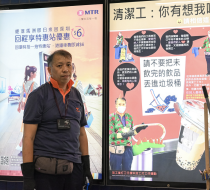Art, Advocacy, and Action: Luke Ching's Crusade for Labor Rights in Hong Kong Favorite
Luke Ching Chin Wai is a conceptual artist and labour-artivist in Hong Kong. Since 2013, he has worked undercover in different low-paid jobs in the city, including as a security guard, supermarket cashier worker, and metro cleaner to learn about poor people's working conditions. He then uses these experiences to create art and push for improved labour rights.
Coming from a grassroots family, Ching finished his Master of Fine Arts at the Chinese University of Hong Kong in 1998. His early work addressed Hong Kong’s unique language, culture and public spaces through photos, images, performances, videos, sounds, visual exhibitions, etc.
Since the mid-2000s, Ching started challenging the collusion between capital and arts in the city’s art scene. In 2008, together with other artists and cultural workers, he was involved in a campaign to hijack public spaces with art. One of the hot spots was the public space outside the Times Square in Causeway Bay. In 2009, Ching appeared at the press conference of an art exhibition, “Louis Vuitton: A Passion for Creation,” to protest against the exhibition of collusion as he saw the luxurious brand’s attempt to use art for publicity purposes.
Ching’s labour-artivist journey began in 2007 after a security guard at the Hong Kong Museum of Art told him that he had to stand all day long during his shift. The artist then wrote a comment in the museum guest book, asking the management to provide chairs for guards. Later, he turned his action into a “chair movement” by inviting others to join him, and after six months, the museum guards finally were allowed to sit during their shifts.
The chair movement
Luke Ching explained the idea behind the campaign in a video:The chair movement for security guards is a campaign to alleviate job-related injuries for security guards who have to stand for a long period during duty. It is also a campaign for workers to fight for their autonomy and I hope that it can be developed into a city-wide campaign to connect off-duty and on-duty wage earners.
Eventually, he successfully pressured two supermarket chains and a cinema chain to provide chairs for their cashiers and staff during duty. Ching’s chair movement project was presented in “An Art Exhibition for the Working Poor”, organized by Oxfam in 2017.
Later, in order to reach out to more workers, Ching created a Facebook page: “A movement for off-duty wage earners support on-duty wage earners” (放工後打工仔女撐未放工打工仔女運動). During the COVID-19 pandemic, one of the most exploitative jobs became outsourced cleaners who were responsible for maintaining public hygiene. After local reports showed that some cleaners were forced to have their lunch at their workplaces in toilet stalls and garbage collection stations, Ching started speaking out for the cleaners by criticizing the design of rubbish bins and garbage collection stations.
On November 1, 2021, he began working at Tai Wai Mass Transit Railway (MTR) station as an outsourced cleaner. Three months later, he launched a silent stand protest to protest against the exclusion of MTR outsourced cleaners in the government’s pandemic relief subsidy scheme. Luke Ching's undercover worker project is to uncover the exploitative outsourcing work system adopted by the Hong Kong government.Apart from staging protests, he also invited his colleagues to express their discontent through photo collages.
Taking the opportunity of the city's annual art event, Art Basel 2023, Luke Ching raised some funds and bought an Advertisement at Tai Wai MTR station to teach subway passengers how to handle their rubbish (see feature image). He reflected on the meaning of his action on a social media post:
"I watched the crowd-funded advertisement unfold at Tai Wai MTR and spent the rest of the day making sense of this seemingly strange landscape. After rounds of negotiation with the MTR company, we finally managed to put up the advertisement inside the station. The message is clear: the cleaning workers can speak for themselves in their workplace. It also lets people see the cleaner’s work lies behind the garbage. This is a gentle and reasonable request."
For Ching, grassroots workers should enjoy the right to express themselves during their work. Thus, he would sing his favourite songs during his duty and encourage his colleagues to do the same. Some of his other artwork includes badges, such as cockroaches and painkillers, that can be worn during duty to notify others about their bad mood.
Luke Ching spent almost two years working as a cleaner in MTR before he took a few months retreat to Sweden in July 2023. He returned to Hong Kong and his undercover MTR cleaner project earlier this month.
After the enactment of the National Security Law (NSL) in Hong Kong, the Hong Kong Confederation of Trade Unions was forced to disband. Between 2020–2022, 178 worker’s unions have been delisted from the union registry and the annual International Worker's Day protest has also vanished due to political pressure. Luke Ching’s art intervention attempts to inspire other wage earners to carry on the labour rights movement in their everyday lives.







